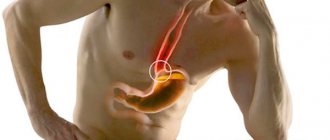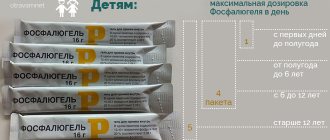What is a bezoar?
A bezoar, forming in the stomach, is a lump that subsequently interferes with the digestion of food and contributes to the retention of any elements (food, hair, etc.), thereby increasing in size more and more.
In some sources, the term gastric bezoar does not imply the presence of a stone in the intestine, which, on the one hand, is correct. But there are cases when a bezoar can be in the stomach and continue in the intestines, so the article uses the wording bezoars of the stomach and small intestine. Stone formation always begins in the stomach!
How to treat?
Bezoars will help break down a gentle massage of the stomach.
If there are no complications, the pathology is treated with conservative methods, which are selected depending on the type of agglomerate and its characteristics. A soft, small calculus should be treated with warm alkaline mineral water for up to 2 weeks, a diet with limited consumption of raw vegetables and fruits, and laxatives. A gentle massage of the stomach will break up the bezoars and speed up elimination.
A mechanical method is used to remove the clot using an endoscope, as well as a method of crushing it with a stream of special solutions under pressure. To speed up the elimination of residues and traces of agglomerate, prokinetics that increase gastric motility and enveloping drugs are prescribed. But large, dense bezoars require opening the stomach (gastrotomy). Abdominal surgery is indicated if other treatment methods are ineffective.
The main reasons for the formation of bezoars in the stomach
Bezoars, or stomach stones, can occur in both children and adults. In addition, a bezoar can advance and form in the cavity (lumen) of the small intestine, which leads to certain complications.
Who is most likely to have this pathology?
- In the first place are children and people with neuropsychiatric disorders who can chew, lick and swallow their hair. There is a certain addiction called trichotillomania (pulling out one’s own hair), and it is precisely in such people with a disturbed psyche that bezoars can form. People working in industries related to wool and hair processing, and hairdressers may also be at risk.
- Patients who have undergone certain surgical interventions on the stomach and small intestine are also susceptible to the formation of stones in the stomach. In this case, the predisposition to the formation of bezoars arises due to the fact that the process of digestion and further evacuation of food is disrupted, thereby undigested food particles are retained and “stick” to each other, over time forming a kind of lump.
- Fans of fiber (in particular, the well-known persimmon fruit), animal fats - fatty foods (lamb, beef, goat, etc.) may be susceptible - crystallization of fat molecules occurs under the influence of digestive juice (hydrochloric acid plus enzymes) and the formation of stones .
The gastric trichobezoar is the most common variety among all known bezoars.
In order for pathology to form, certain conditions are needed, that is, it is rather a combination of factors in this case. In general, I want to say that a bezoar will not form if you allow yourself to eat persimmon, for example, once a week.
Causes
The main factor is a violation of motor functions, which are responsible for the evacuation of food lumps from the stomach into the intestinal tract. A typical provoking disease is complicated diabetes mellitus (diabetic gastroparesis, partial gastric paralysis). There are other, no less important, causes of stones in the stomach:
- Weakened secretion of the gastric glands, low acidity.
- Colonization of the intestinal tract and stomach by microorganisms that disrupt the microflora (yeast-like fungi).
- Increased viscosity of mucus.
All those who chew food poorly, abuse coarse and fatty foods, those who have undergone surgery on the stomach (partial resection, vagotomy) and those who do not undergo a follow-up examination can get this disease.
The stone can remain in the body for a long time without causing any unpleasant symptoms. As a result, a person does not even know about his illness for many years. When a stone reaches a certain size, it can trigger an attack or cause discomfort. As a rule, unpleasant sensations are observed from a stone in the stomach after eating. Patients with this disease are prescribed a special diet.
Interesting facts about bezoars. Mention in history and literature
In literature, a bezoar often appears as a stone that is endowed with special properties. For example, a bezoar can protect against the toxic effects of arsenic and other poisons. Or, for example, by dissolving a bezoar in wine, you can get a drink that will cure almost any disease. Of course, all this is not true, although if you delve into history, you can find information that there were attempts to treat various diseases with stones (bezoars).
Photo: https://www.flickr.com/photos/jdicert/6238846272/
There is also a mention that special stones were even “grown” in the stomachs of the poor! And that the princes wore fragments of bezoars in their rings as an antidote.
Modern cinema uses this pathology in various TV series (for example, House Doctor) and films about doctors. Since the disease is quite rare, but unusual and interesting!
Preventive measures
It is easy to prevent the formation of a bezoar in the stomach if you follow general recommendations for proper and healthy nutrition and lead an active lifestyle. It is important to get rid of the habit of biting your nails and sucking hair (especially for children), and undergo a timely examination by a gastroenterologist if there are pathologies in the gastrointestinal tract. Particular attention should be paid to the nature of eating food: you need to eat slowly, chewing food thoroughly, and do not starve or overeat.
It is not recommended to abuse rough foods, fruits, and berries with thick skins.
Classification
Bezoars can be of different origins, that is, have different compositions.
So, what could such a stone consist of:
- trichobezoar - a stone made of hair, wool or fiber (thread);
- phytobezoar - a stone made of cellulose (dietary fiber);
- steobezoar – a stone made from crystallized fats (tard);
- organic bezoar - a stone made from blood clots treated with gastric juice;
- embryonic bezoar - a stone in a newborn child (meconium stones and stones from a cyst formed in the prenatal period);
- mixed stones.
Types of bezoars
If you have a cat, then you must have seen the animal regurgitate a ball of hair - it is called a trichobezoar. The same stomach bezoars can form in humans, for example, in mentally ill people who have the habit of eating their own hair.
There are quite a few types of this disease, here are the most common ones:
Phytobezoars are a type of disease in which a foreign body in the stomach consists of various plant fibers. Typically, a foreign body of plant origin that enters the stomach (seeds, seeds of various fruits or berries) is the basis for the formation of stones. It becomes overgrown with layers of mucus, fat, hair and gradually mineralizes.
Very often, the formation of phytobezoars is associated with high consumption of persimmons. This fruit contains a large amount of astringent and resinous substances, which are an ideal basis for the formation of stomach stones. There are especially many of them in unripe fruits.
Trichobezoars are agglomerations consisting of hair. In medicine, many cases have been described in which mentally ill people ate their own hair.
Pharmacobezoars are a type of gastric stones, the basis of which are various types of insoluble drugs.
The most common of the above-described types of disease are phytobezoars and pharmacobezoars. Phytobezoars account for 70-75% of the total number of cases of this disease.
Although, it should be noted that other materials can serve as the basis for the formation of gastric stones: chewing gum, blood (hematobezoar), casein and much more. Usually they are quickly eliminated from the body, but under the influence of certain factors they can become the basis of a bezoar of the stomach.
There are other, more exotic types of this disease, they are even rarer. The medical literature describes pixobesoars - this is a pathology that occurs due to the habit of chewing resin or var. Eating large amounts of animal fat can lead to sebobezoars, and consuming polishes and nitro-varnishes can lead to shellac-bezoars. Children who are bottle-fed may develop lactobezoars, which are based on lactose and casein.
What symptoms may indicate the presence of a bezoar?
Symptoms of bezoars can vary, especially in intensity. Such stones can reach significant sizes and weights (more than one kilogram!).
Of course, it should be said that complaints cannot always help in early diagnosis. In this case, it is very important to determine not only the existing symptoms, but also to find out the conditions in which the person lives and works, what he eats, behavioral characteristics, etc. Unfortunately, this condition is not always observed by doctors due to lack of time for the patient, but specifically with regard to this pathology (formation of stones in the stomach), a life history could help in diagnosis.
What do patients with gastric bezoar complain about?
Main symptoms of the disease:
- heaviness in the abdomen, especially in the epigastric region;
- quick satiety after eating;
- feeling of fullness after eating;
- pain in the abdomen;
- refusal of food in some cases;
- nausea;
- vomit;
- heartburn;
- belching;
- weight loss.
Trichobezoar of the stomach
Return to section:
Therapy
Patient V., 19 years old, was examined and treated at City Hospital No. 40 from November 19, 2009 to December 10, 2009. From the anamnesis it is known that several years ago, due to psycho-emotional stress (death of close relatives), she began to eat her own hair, "to have something to do." She was operated on several times for gastric trichobezoar.
In September 2009, hypochromic anemia was detected. She was treated on an outpatient basis with iron supplements. Due to the progression of anemia, she was referred to the therapeutic department of City Hospital No. 40.
Upon admission, the patient complained of lack of appetite, weakness, and pain in the epigastric region. Palpation of the abdomen reveals a round formation in the epigastric region measuring 15x5 cm, mobile, painless.
Clinical blood test: hemoglobin 89 g/l, red blood cells 3.4×1012/l. Serum iron – 3.8 mmol/l.
She was consulted by a psychiatrist and diagnosed with obsessive-compulsive disorder (trichotillomania).
Based on complaints, anamnesis, objective and laboratory examinations, it was impossible to exclude a trichobezoar of the stomach.
Fibrogastroduodenoscopy revealed that the lumen of the stomach is 2/3 filled with trichobezoar (Fig. 1).
In addition, an ulcerative defect of the pyloric part of the stomach was revealed (Fig. 2).
Conclusion: Trichobezoar of the stomach. Ulcer of the pyloric stomach.
Thus, the final diagnosis was made: Trichobezoar of the stomach. Ulcer of the pyloric stomach. Moderate chronic iron deficiency anemia.
Comprehensive treatment was carried out:
- therapy for obsessive-compulsive disorder;
- surgical removal of the trichobezoar;
- therapy for peptic ulcers and chronic iron deficiency anemia.
During treatment, the psycho-emotional state improved, the pain syndrome was relieved, and the hemoglobin concentration increased to 101 g/l. The patient was discharged on December 10, 2012 in satisfactory condition with recommendations for further treatment in the neurosis clinic.
Commentary on the clinical case
Bezoars (bezoar stones) are foreign bodies that are often found in the gastrointestinal tract of ruminants and are used for medicinal purposes, including in traditional Chinese medicine. The name comes from the Arabic word "bedzehr" or the Persian word "padzhar", which means "prevents poison".
The first description of a bezoar in a human was made in 1779 during an autopsy of a patient who died of gastric perforation and peritonitis.
Trichobezoar of the stomach is a rare disease that occurs predominantly in young people (80% of patients under 30 years of age), females (90%) with the presence of neurosis or mental illness.
Despite their long history, bezoars are rare, with just over 500 cases described to date. Trichobezoar develops in only 1% of patients with trichophagia.
There are several types of bezoars:
- phytobezoars, consisting of plant fiber that is not digested under the influence of gastric juice (fiber from persimmons, dates, wild dogwood, less often apples, bananas);
- trichobezoars (a ball of hair, sometimes wool mixed with mucus and food); Trichobezoars are caused by trichotillomania (pulling out scalp hair, eyebrows and eyelashes) and trichophagia (swallowing hair). In addition to their own hair, children can also pull out and eat the “hair” of dolls and the bristles of toothbrushes;
- lactobezoars (contain undigested milk);
- sebobezoars (animal fat);
- pixobesoars (consist of resinous substances and are found in people who use alcohol substitutes, BF glue, polish);
- shellac-bezoars (bitumen or tar stones among the inhabitants of Central Asia, who sometimes have the habit of chewing and swallowing tar and bitumen);
- anthracobezoars (coal stones);
- medicinal (magnesium) bezoars.
The rate of formation of bezoar stones depends on their nature and ranges from 1-5 days to several years. Their sizes and shapes are also different. Bezoars are localized most often in the stomach, less often in the esophagus and small intestine.
The clinical picture of gastric bezoars is varied. The onset of the disease is usually asymptomatic; As the bezoar grows, periodic pain and a feeling of heaviness in the abdomen, nausea, vomiting, and loss of appetite appear; laboratory tests often reveal chronic iron deficiency anemia. With large sizes, bezoars can be palpated through the anterior abdominal wall. Complications of bezoars are erosions and ulcers of the stomach with bleeding, perforation of the stomach wall with the development of peritonitis, obstruction of the small intestine with subsequent perforation. Treatment is usually surgical. Less dense bezoars (phytobezoars, piscobezoars, sebobezoars) can be removed endoscopically.
The clinical picture of trichobezoars does not differ from that of bezoars of other origins. An extremely rare occurrence is Rapunzel syndrome (named after the princess from the fairy tale of the Brothers Grimm) - a trichobezoar that constantly increases in size due to the accumulation of non-absorbable dietary fiber and reaches the loops of the small intestine.
Treatment of trichobezoars is surgical.
Thus, our observation represents a typical case of trichobezoar that developed in a young woman with neurosis.
Literature
- Sidorov P.I., Mikheeva V.V. Trichobezoar of the gastrointestinal tract in the clinic of childhood neurosis // Journal of Neurology and Psychiatry. - 2000. - No. 2. - P. 59–60.
- Gonuguntla V., Joshi D.-D. Rapunzel syndrome: a comprehensive review of an unusual case of trichobezoar // Clin. Med. Res. - 2009. - Vol.7, N 3. - P. 99–102.
- Kement M. et al. Synergistic effect of multiple predisposing risk factors on the development of bezoars // World J. Gastroenterol. - 2012. - Vol. 18, N 9. - P. 960–964.
- Oh SH et al. Bezoar-induced small bowel obstruction // J. Korean Soc. Coloproctol. - 2012. - Vol.28, N2. — P. 89–93
Bogdanov A.N., Anisenkova A.Yu., Belokopytov I.Yu., Efendiev A.O., Esinkina M.V., Savilova I.V., Azarenko S.V.
← Back
How is the diagnosis confirmed?
The diagnosis is confirmed using special diagnostic methods. X-ray examination methods (X-ray, fluoroscopy), fibrogastroduodenoscopy (FGDS) and ultrasound examination of the abdominal organs. All of these methods confirm the presence of a bezoar in the stomach or small intestine.
Photo: https://pixabay.com/photos/hypertension-high-blood-pressure-867855/
When performing an X-ray examination, a special contrast agent is used. The images reveal a round formation against the background of a filled cavity (stomach cavity) with contrast. When using fibrogastroduodenoscopy (FGDS), it is possible to study the formed formation in more detail and differentiate it from a tumor in the stomach. FGDS also makes it possible to take material (pinch off a piece of stone) for a more detailed study.
CT (computed tomography) and MRI (magnetic resonance imaging) methods can be used to determine in more detail the location and structure of the bezoar.
Diagnosis of bezoar
Due to the fact that the symptoms in the presence of a bezoar are not characteristic, in some patients the exacerbation of this problem is mistaken for food poisoning. In this case, the doctor prescribes plenty of water, mainly mineral water, and gastric lavage, which somehow gives relief as a result of removing bezoar masses from the stomach. The exacerbation itself can occur as these bezoar masses accumulate and subside after they enter the duodenum or are excreted through vomiting.
If the size of the bezoar is sufficiently dense, it can be palpated in the epigastric region, but there is a possibility that a bezoar in a stationary state may be mistaken by the doctor for a tumor. For this reason, X-ray, echographic and endoscopic research methods are of great importance in diagnosing a bezoar. A laboratory blood test may reveal anemia.
In any case, to establish the correct diagnosis, the doctor must conduct a thorough analysis of the anamnestic data obtained from the patient, namely: previous stomach surgeries, consumption of food of plant or animal origin and the presence of bad habits that can provoke the formation of bezoars, as well as the condition of the teeth, nature of chewing and swallowing food.
Treatment of bezoars
Treatment of bezoars can be surgical or conservative. It all depends on the size of the stone. If the stone (bezoar) is less than five to six centimeters in diameter, then conservative treatment tactics are initially used. If the stone is larger than the above dimensions, then, of course, surgical intervention is required.
Conservative treatment method
Includes the following activities. Firstly, it is prescribed to drink a special solution of baking soda in a concentration of 5 - 10% (sodium bicarbonate solution), massage the stomach area using gentle stroking, warm baths (the abdominal area should be completely immersed in water) to relieve pain and cramps, antispasmodics (No-spa, Papaverine, etc. in tablets or better in injections, taking into account these circumstances). Conservative measures do not always lead to success, and you have to resort to surgical interventions.
Minimally invasive techniques and surgical treatment of bezoar
With the help of fibrogastroduodenoscopy (FGDS), this method rather refers to conservative treatment or to minimally invasive intervention (that is, it does not require additional incisions or accesses) they try to break up formed stones, this method is also only suitable for small bezoars, like methods of conservative therapy.
Surgery involves an operation called gastrotomy. Using a series of incisions, they enter the stomach cavity and remove the bezoar mechanically, then the wounds are sutured.
Bezoar removal is a prerequisite for treatment! A stone that is not removed can cause severe and unpleasant consequences, which may result in even more extensive surgical interventions than during the initial surgery.
Symptomatic picture
A stomach stone can remain in the gastric cavity for quite a long time without manifesting itself in any way. When the formation acquires a certain size, the first signs begin to appear in the form of:
- dull or aching pain in the abdomen after eating;
- instant satiation even with a small amount of food eaten;
- heaviness in the abdominal area;
- nausea;
- belching with an unpleasant odor;
- gagging after eating.
The symptomatic picture directly depends on the size of the formation and its location in the intestinal canal. If the formation appears in children, then severe abdominal pain and swelling of the body are observed.
When large stones occur in the stomach, symptoms appear:
- weight loss;
- frequent infections of a viral and infectious nature;
- fatigue, weakness, chronic fatigue;
- brittle nails, deterioration of teeth;
- unhealthy skin tone.
Acute pain syndrome and repeated vomiting occur if a stone is pinched in the stomach at the outlet of the organ.
Preventing the formation of stones in the stomach
Since the most common type of bezoar is a trichobezoar, prevention in this case is aimed at sedative therapy in psychiatric patients and the formation of correct behavior in children (the child should be explained why this cannot be done in calm conditions), just as the method can be applied to short haircuts in children. these risk groups.
Special protective equipment (masks, respirators) are necessary for people of various professions who deal with hair, wool and fibers of other nature.
Photo: https://pixabay.com/photos/smoothies-fruit-fruits-vegetables-3809508/
In cases of the formation of phytobezoar and steobezoar stones, we are talking about diet. That is, limiting certain types of food and eating patterns.
People after surgical interventions should also remember about the diet (gentle cooking and fractional meals) in order to prevent complications in an already weak stomach or intestines.
Prevention
Proper nutrition is the main preventive measure to prevent the formation of stones in the stomach. In addition, doctors recommend the following:
- an active lifestyle with a sufficient level of physical activity;
- chewing food thoroughly and slowly;
- getting rid of the bad habit of biting nails and sucking hair;
- reviewing the diet, limiting fruits and vegetables with hard peels, berries, roughage, as well as baked goods, white bread, which is best replaced with bran;
- periodic examination by a gastroenterologist.
You don’t need to completely exclude meat products from your diet, but you don’t need to get carried away with them either. You need to drink at least two liters of liquid every day (pure water, tea, rosehip infusion, etc.), this will prevent dehydration.
It is important to empty your bowels on time to prevent stool from accumulating. It is useful to massage your tummy in the morning and drink warm boiled water. You can also sit down a couple of times. They do all this in order to form the habit of going to the toilet at the same time every time.
Possible complications
Complications develop, as a rule, in patients with large bezoars, with undiagnosed bezoars (a sudden manifestation is possible, that is, everything begins with a complication) and when patients refuse surgical interventions (not immediately, after some time).
A bezoar, localized on one of the walls of the stomach, can provoke a so-called bedsore of the wall. With the pressure created by the stone (bezoar), the stomach wall is poorly supplied with blood and does not receive enough oxygen. Areas of ulceration (ulcers and erosions) may form in this area.
In the future, when the process is started, there may be perforation of the wall, that is, a hole (hole) is formed at the site of the ulcer and the contents of the stomach are poured into the abdominal cavity, which entails the development of peritonitis (purulent melting) and sepsis (contamination of various organs by bacteria through the blood vessels). All these complications are acute surgical pathologies and require emergency medical care (specialized surgical care).
And another complication is intestinal obstruction. It develops in cases where a bezoar penetrates the cavity of the small intestine and “grows” there. Intestinal obstruction can also trigger the development of peritonitis and sepsis and also requires immediate medical attention.
Shaving:
This is probably the simplest and most common of all the methods that help get rid of stomach hair. When taking a shower, you can simply rinse the stomach area with warm water. This will soften the hair on the stomach area and also prepare it for shaving. Washing the area is necessary because wet hair makes it easier to shave and also reduces the number of cuts. Then apply a mild shaving gel to the hairy areas of your belly. Then shave the hair from your belly where you applied the shaving gel. Be careful when shaving and be careful when using the razor. Also, every time you use the razor, make sure to wash it and store it after shaving. It is advisable to rinse the razor with warm water to disinfect it.










